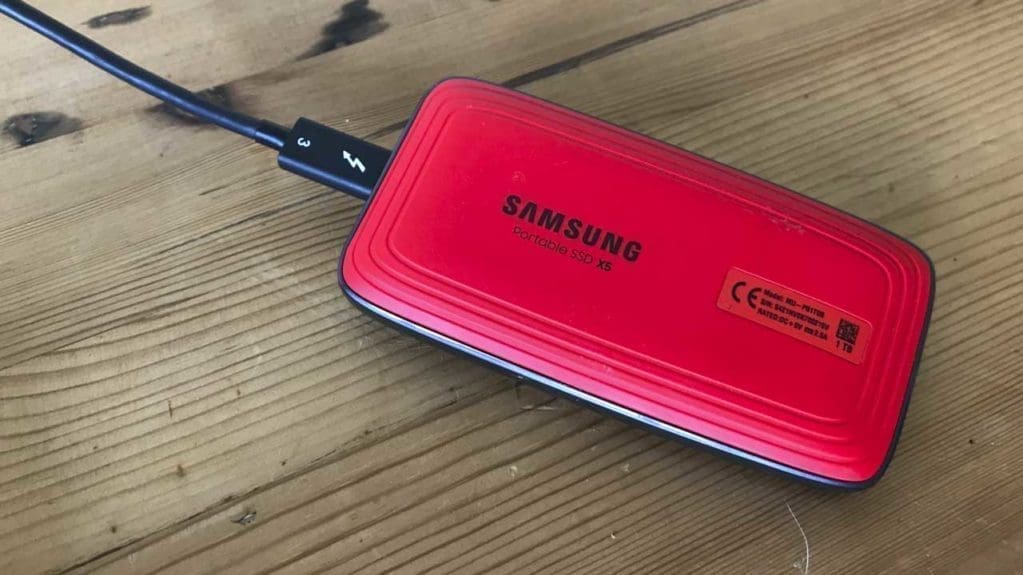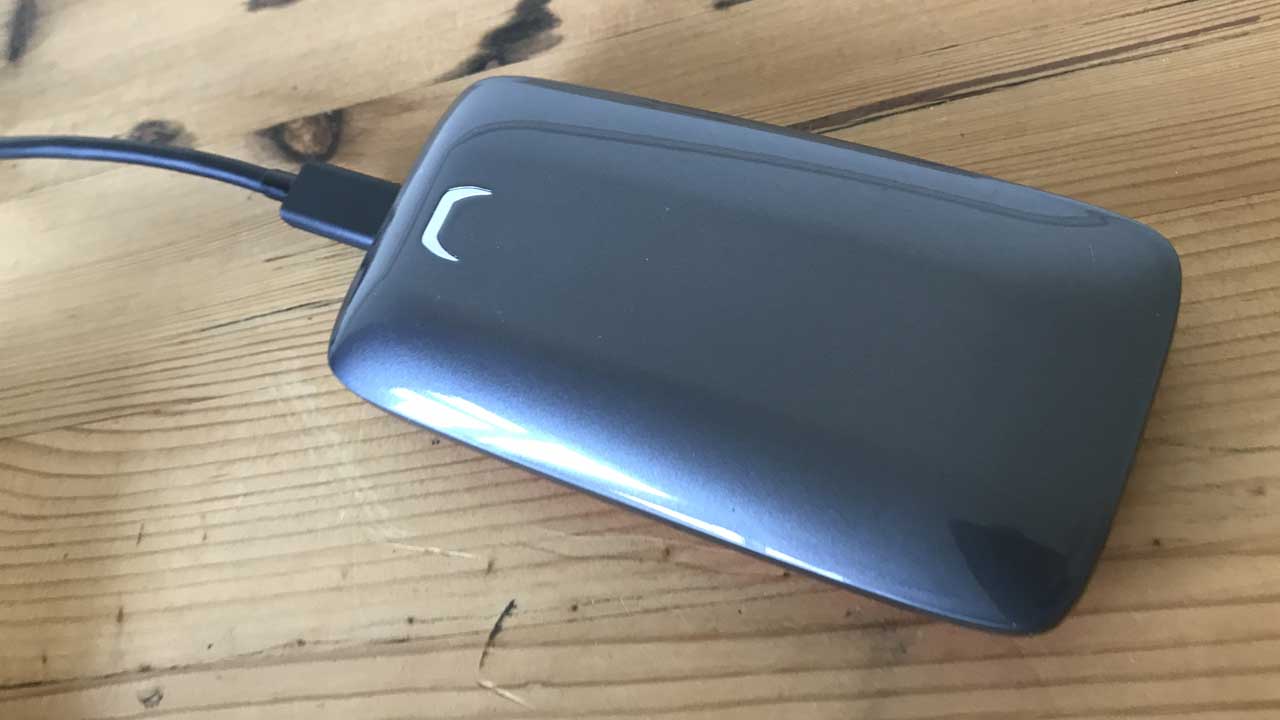The Samsung X5 is the latest generation portable hard drive. It features super-fast Thunderbolt 3 and a high-capacity NVMe solid-state drive.
The design is sleek and simple, and the size perfect for slipping into a side pocket on almost any style of camera bag.
Initial setup is easy, just follow the built-in software to optimise the drive for your system.
Our testing showed the X5 to be blisteringly quick, with speeds of more than 2000MB/s.
This proved that the X5 would make an ideal choice as a working drive for editing high-resolution 4K video.
Portable drives are inevitably more expensive than standard external hard drives, but when you couple capacity with speed the X5 is very reasonable.
If you’re looking for an external hard drive to use as an expanded capacity working drive, then the Samsung X5 is an ideal choice.
What is the Samsung X5?
Swapping your old desktop for an ultraportable laptop makes sense, however, one big issue you’ll face is storage. You just can’t stuff in terabytes of data into the compact form of the latest MacBook or ThinkPad.
It, therefore, goes without saying that we should look at portable storage solutions such as the Samsung X5.
Portable hard drives fill in that storage void often left by the moderate capacity internal laptop hard drives.
While there are plenty of external portables out there, few truly offer the read and write speeds that enable their use as true working drives. Really the majority are just portable storage devices.
However, the Samsung X5 is the latest generation portable hard drive and it, therefore, packs in the features. These include an ultra-fast Thunderbolt 3 connection and high-capacity NVMe solid-state drive (SSD) which means that as well as storage it can be used as a viable working drive.
Features
The compact Samsung X5 features Thunderbolt 3 technology and the latest NVMe drive, this coupling will give read speeds of up to 2800mb/s and write speeds of up to 2300mb/s, at least that’s as quoted from the Samsung website.
Thunderbolt 3 technology ensures fast data transfer, up to 40GB/s, but all that speed would come to nothing if the X5 didn’t feature a drive capable of handling data quickly.
Inside is Samsung‘s latest NVMe drive, this technology is being increasingly used on high impact, high-demand applications so is ideal for anyone handling video especially 4K and higher resolutions.
The X5 will come in a choice of capacities with 500GB, 1024GB, 204GB versions priced at £359, £629 and £1263.
Externally the drive’s enclosure is made of high impact plastic, this should help to ensure it stays protected in your bag. Samsung has tested the durability of the drive with a drop up to 2m.
On the Samsung site, they show an impressive exploded view of the drive. This shows the protection guard and heat sink that helps to keep the drive cool, apparently below 45º C at all times.
As the drive contains no moving parts, unlike an optical drive, it is far more robust, so a much better solution all around for a photographer on the move.
Storage and speed may be the main features but as a portable drive, there is, as ever, the possibility that it will get lost. To prevent your data falling into the wrong hands the drive features AES 256-bit Encryption. During setup, you’re asked if you want to use this feature and it will lock the drive requiring a password to gain access.
Size-wise the drive measures 22 x16 x 20mm and weighs in at 146g or 168g once the cable is attached.
Build quality and handling
When you first open the box and reveal the Samsung X5, you could easily mistake it for a computer mouse. It essentially looks like one of the high-tech sci-fi style gaming mice that you often see.
Smooth, curved and featuring a high gloss black finish with an underside that is covered by a rubberised red base.
As ever the Samsung build quality is excellent and it all feels built to last, it also has a decent weight to the whole thing which is reassuring.
Unlike many other drives, the Thunderbolt 3 cables can be fully removed. I really like this feature as it means that depending on where you’re using it you can change the cable length to suit.
I’m also quite a fan of the new USB-C / Thunderbolt 3 connection. It seems to make far more sense than the old USB 3.0 which I thought was one of the worst connectors of all time, and was the cause of the accidental destruction of more than one drive.
Other than that when it comes the drive itself there really is very little to the physical device.
As a drive, the physicality is only the start, the real handling and performance really start once the drive is connected.
As soon as you plug the drive into your machine a small dialogue window appears, that is as long as you have AutoRun enabled, otherwise you need to click the set-up.
This dialogue enables you to set up the drive ready for use on your operating system, this is an important step of setting up any new drive.
Having the correct format for your drive is hugely important if you’re to avoid unnecessary crashes and losses of partitions, which can be a real pain, no, devastating.
It’s great to see Samsung handhold you through the process and ensures that you’ll get the absolute optimum performance from the drive.
Once you’re finished installation you’re ready to get started with using the drive. Either as storage or as a working drive.
Performance
As with any portable hard drive, the real proof of quality comes down to longevity. How long will the drive last in real working conditions, and more importantly will it survive life as a working drive that spends most of its time being thrown into and around a camera bag?

In our test I used the drive solidly for a couple of weeks, really putting it through its paces both physically by throwing it into a camera bag or pocket and as a working drive.
Over the weeks I used it to store and edit 4K video shot on the Sony 7 III.
The drive was tested on a MacBook Pro i9 with 32GB of RAM using the Blackmagic Disk Speed Test.
The Samsung X5 proved excellent and although it didn’t hit the read/write speeds quoted on the Samsung website is was close.
In the 1GB test, it managed an average write speed of 2160MB/s and Read speed of 2431MB/s. As these scores were average it wasn’t a huge amount behind the stated fastest read/write speed.
These read and write speeds are more than adequate to edit 4K video in any format from pretty much any consumer camera.
Verdict
The Samsung X5 is just one of the many new fast external hard drive to emerge recently.
It is, however, one of the few that features Thunderbolt 3 over USB-C. This means that it offers far faster read and write speeds than the majority of the competition.
I felt the design, although slick, did look a little bit dated and slightly blingy. I would’ve preferred something that felt a little more robust with a slightly rubberised texture.
Had the rubberised material of the base been used for the entire construction of the exterior that would have been ideal.
My reasoning for this is that when working in a studio where drives are often handed from one photographer to another, left lying around on tables anything that gives the drive a little extra grip to avoid it being accidentally knocked off a table or being dropped is welcomed.
The new Thunderbolt 3 connection has been widely adopted by Apple, and I have to say that it’s probably one of the best and most secure connectors that I’ve used in years.
I might not be bowled over by the anaesthetics but I can certainly see it’s appeal, albeit from a gaming angle when it comes to the design.
When it comes to performance there’s nothing I can say against it.
The read and write speeds are blisteringly quick and more than adequate for editing 4K video. There’s no linger time as you edit and you’re very unlikely to see the spinning beach ball of doom.
Used in conjunction with the latest i9 MacBook Pro and the performance of this drive is exceptional, but as I pointed out to Jeff there is one major issue.
When it comes to speed the X5 is fast, this means that your workflow will increase hugely as there is less time needed for your computer to read and write to the disk.
Because of this when it comes to rendering video there is less time to wait and because there is less time to wait there is less time to go and grab a coffee, pop out to the shops, or go do something else. All because your machine and the drive has already finished doing what it should be doing.
If you’re looking to increase the amount of work you do and want to reduce the amount of time that you’re doing it, then definitely go pick up a Samsung X5.
If you’re on the payroll and you’re editing and rendering out video then I highly recommend you find yourself a nice old high-capacity optical drive instead and claim back a more sedate way of life.
For more information check out the Samsung X5 at samsung.com



